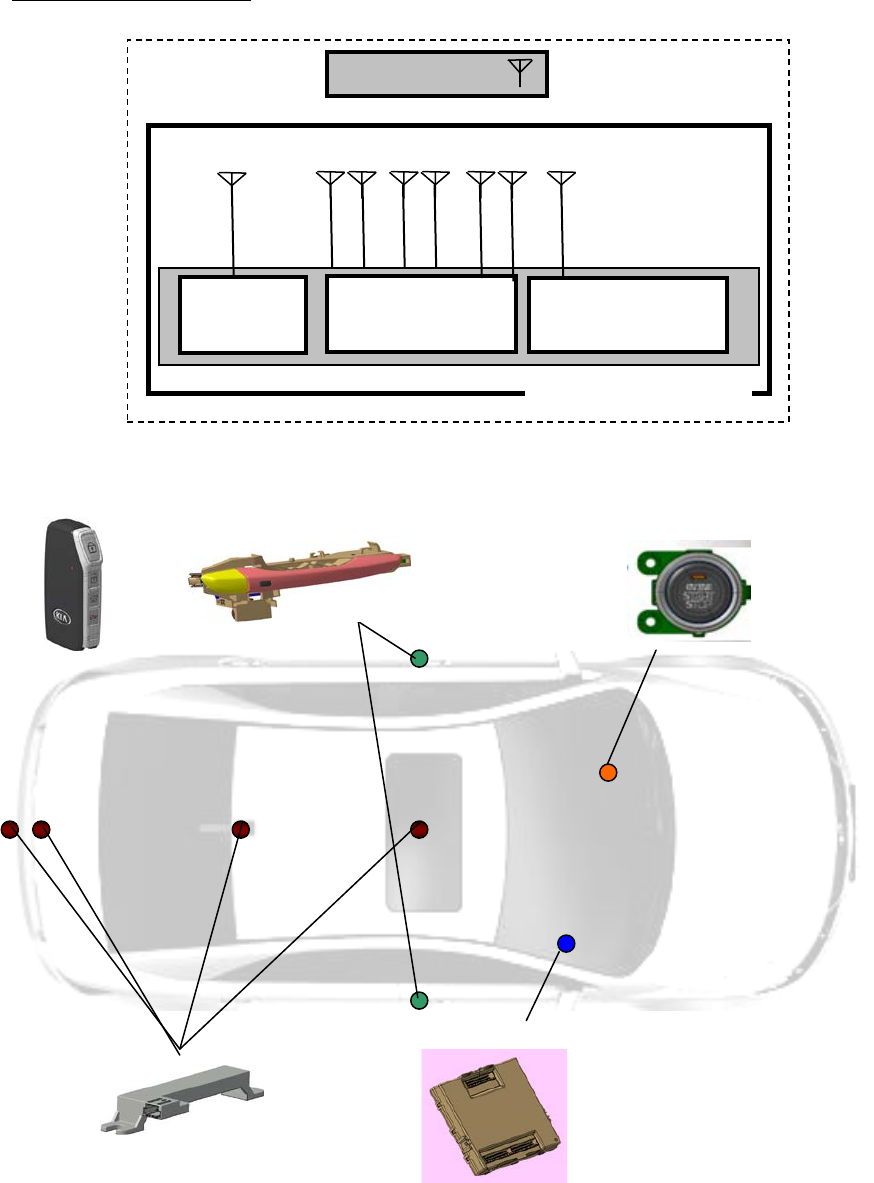DENSO Korea EG07170 IBU_SMK User Manual Information
DENSO KOREA ELECTRONICS CORPORATION IBU_SMK Information
User manual

3.Outline of the system
Existing BCM, SMK, TPMS receiver integrated ECU as well as smart key function. Body
and TPMS related control unit (integrated PDM, RF Receiver). It controls the power
operation mode (ACC, IGN1, IGN2, START) of the vehicle according to the operation of
the START / STOP button when the card key / FOB is successfully authenticated.
Various Lamp, Indicator, Rear Curtain, Side mirror, Relay control related to BCM function
Directly and indirectly, and performs a warning and display function for processing data
received from the TPS sensor.
3.1. IBU WSMK
Smart Key System
The smart key unit controls the smart key system. When the user inputs the door handle
or the start button, the smart key unit transmits the LF signal (134.2 KHz) to the smart
key FOB and receives the signal (433 MHz) from the FOB to perform a related function .
● Terminal control function: Control terminal (IGN1, IGN2, ACC) power when inputting
start / stop button
● Immobilizer function: Function for emergency start or RKE key authentication when
discharging FOB battery
● Start stop button LED lighting control
● Electrical steering colume lock (ESCL) control function - excluding domestic / North
American / Canadian specifications
BCM function System
BCM function is a function for user convenience / warning, and it can directly or indirectly
control various indicators, sensor power, hot wire and relay control through
communication or switch input. It also performs Immobilizer function.
● Terminal control function: IGN1, IGN2, ACC power control
● Immobilizer function: Perform function for RKE Key authentication
● Head lamp washer relay control function - Optional function
● Indicator control function
● Auto light control function
● Puddle & Pocket Lamp control function
● Solenoid control function (ATM)
● PAS power control function

● LIN communication
● Chassis CAN communication (500kbps)
● Body CAN communicaton (500kbps)
3.2. LF Antennas:
Inductive antennas in and at the vehicle are used to transform the current, driven by the
SMK antenna driver, into a magnetic field (134.2 kHz), which is the carrier for the SMK
challenge.
Two antenna covers the vehicle’s interior. One antenna covers the interior of the Trunk.
Two antennas in the Door Handles (Left side and Right side) cover the area around the
doors. One antenna in the rear bumper covers the area around the trunk for access to
the trunk. Those antennas are based on ferrite core and have a pair of twisted copper
cables from antenna to pin header.
3.3. Transponder Antenna:
Built in the Start Stop Button to communicate with the transponder by a base
station and using wireless communication :(134.2kHz)

3.4 Installation in vehicle
The Smart Key ECU is installed inside the vehicle.
Fig. Outline of the System
Smart Key FOB
LF ANT
Driver
Transponder
Driver
IBU(SMK 사양)
RF
Receiver
TP ANT
RF ANT
LF ANT
Installation in vehicle
SMK+BCM
With RF Internal Antenna
RF Receiver
and LF Driver
Door Handle with
LF Antenna
Start Stop Button with
Transponder Antenna
LF Antenna
Smart Key FOB
Fig. Installation of the System
FCC Warning
This equipment has been tested and found to comply with the limits for a Class B digital device, pursuant to part 15
of the FCC Rules. These limits are designed to provide reasonable protection against harmful interference in a
residential installation. This equipment generates, uses and can radiate radio frequency energy and, if not installed
and used in accordance with the instructions, may cause harmful interference to radio communications. However,
there is no guarantee that interference will not occur in a particular installation. If this equipment does cause
harmful interference to radio or television reception, which can be determined by turning the equipment off and
on, the user is encouraged to try to correct the interference by one or more of the following measures:
■Reorient or relocate the receiving antenna.
■Increase the separation between the equipment and receiver.
■Connect the equipment into an outlet on a circuit different from that to which the receiver is connected.
■Consult the dealer or an experienced radio/TV technician for help.
Caution: Any changes or modifications to this device not explicitly approved by manufacturer could void
your authority to operate this equipment.
This device complies with part 15 of the FCC Rules. Operation is subject to the following two conditions:
(1) This device may not cause harmful interference, and (2) this device must accept any interference received,
including interference that may cause undesired operation.
IC Warning
"This device complies with Industry Canada licence-exempt RSS standard(s)."
Operation is subject to the following conditions: (1) this device may not cause interference, and (2) this device must
accept any interference, including interference that may cause undesired operation of the device.
Le présent appareil est conforme aux CNR d'Industrie Canada applicables aux appareils radio exempts de licence.
L'exploitation est autorisée aux deux conditions suivantes : (1) l'appareil ne doit pas provoquer de brouillage, et (2)
l'appareil doit accepter tout brouillage radioélectrique subi, même si le brouillage est susceptible d'en
compromettre le fonctionnement.